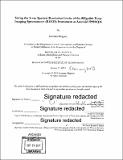Sizing the X-ray spectral resolution limits of the REgolith X-ray Imaging Spectrometer (REXIS) instrument at Asteroid 1999RQ36
Author(s)
Megyery, Suzanna
DownloadFull printable version (10.83Mb)
Alternative title
Sizing the X-ray spectral resolution limits of the REXIS instrument at Asteroid 1999RQ36
Other Contributors
Massachusetts Institute of Technology. Department of Earth, Atmospheric, and Planetary Sciences.
Advisor
Sara Seager.
Terms of use
Metadata
Show full item recordAbstract
The REgolith X-ray Imaging Spectrometer (REXIS), a Charge-Coupled Device (CCD)-based coded aperture soft X-ray (0.3-7.5 keV) telescope for remote geochemical X-ray Fluorescence (XRF) spectrometry, will be flying on board the Origins Spectral Interpretations Resource Identification Security Regolith Explorer (OSIRIS-REx) asteroid sample return mission that will be visiting the asteroid 1999 RQ36 and sending a sample back to Earth. REXIS will detect elemental XRF lines and produce a histogram of results as the spacecraft orbits the asteroid as well as produce a global map of elemental abundance ratios. The accuracy requirement for measuring the global ratios of elements and the spectral resolution requirement for discriminating unique XRF lines from each other have been set in place. The correct interpretation of X-ray measurements from the surface of 1999 RQ36 is limited by properties that are intrinsic to the CCD detector, CCID-41, that has been chosen for REXIS. This thesis study outlines student experimentation and results that were conducted on the CCID-41 detector to gauge the intrinsic detector noise as a function of detector temperature. Further, the widening of spectral lines on the resultant histogram was also equated as a function of detector temperature. Members of the REXIS Team built a spectral resolution model to investigate both the widening of spectral lines as a function of detector temperature and the accuracy of the measurement of elemental abundance line ratios as a function of detector temperature. Data from the student laboratory experimentation suggested that the detector temperature remain at or below -75°C to minimize intrinsic noise properties. Data from the computational analyses of the spectral resolution model suggest consistent results that the detector temperature remains at or below -55°C to remain within the established REXIS requirements. The combination of these three results leads to the author's recommendation that a detector temperature requirement be set that the temperature of the CCD detector onboard REXIS shall not exceed -55°C and that a detector temperature goal be set that the temperature of the CCD detector shall not exceed -75°C.
Description
Thesis: S.B., Massachusetts Institute of Technology, Department of Earth, Atmospheric, and Planetary Sciences, 2013. Cataloged from PDF version of thesis. Includes bibliographical references (pages 64-68).
Date issued
2013Department
Massachusetts Institute of Technology. Department of Earth, Atmospheric, and Planetary SciencesPublisher
Massachusetts Institute of Technology
Keywords
Earth, Atmospheric, and Planetary Sciences.